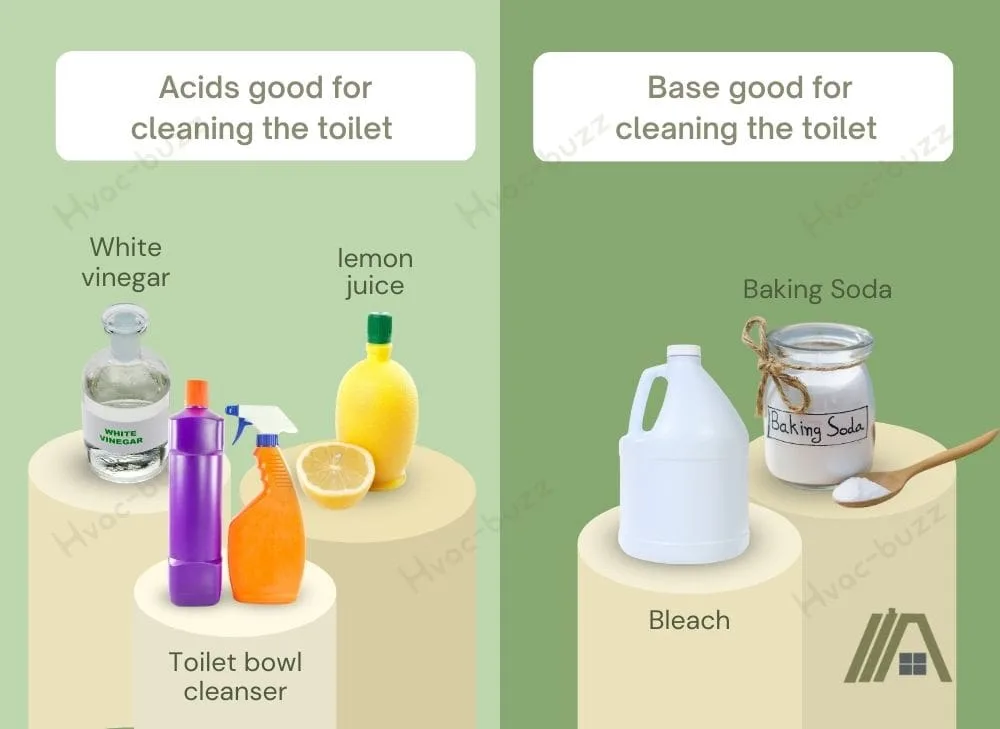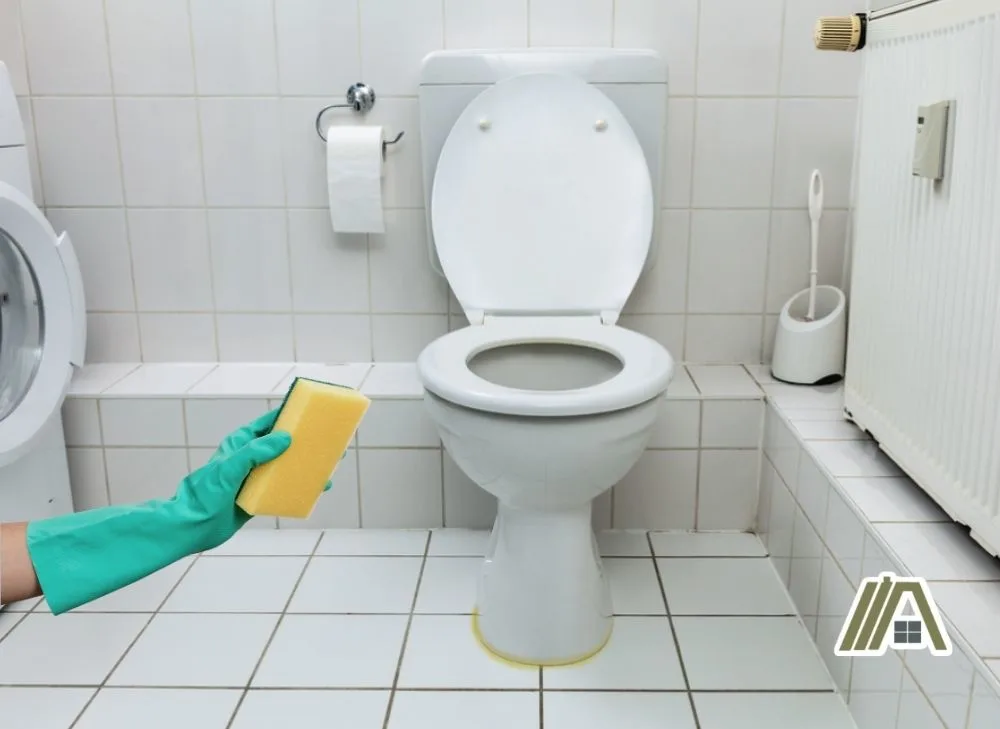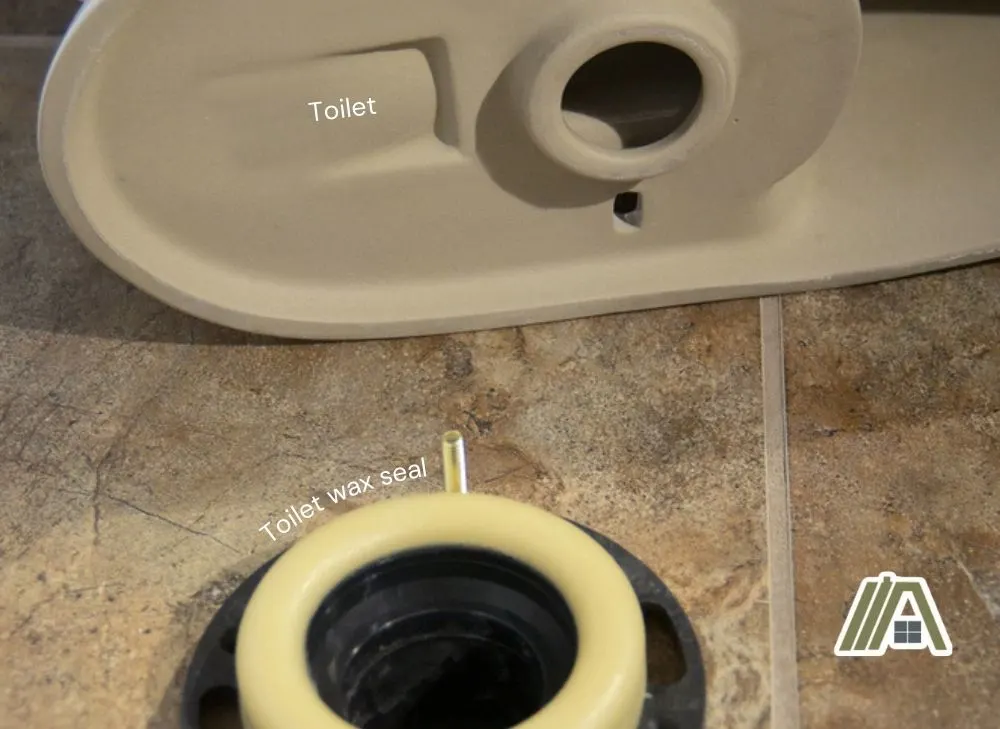Stains, while often harmless and surface-level, can seriously contribute to a space looking less than clean. Take, for example, that yellow, brownish stain around the base of your toilet. This is not a spot you want to see yellow and brown discoloration!
Regardless of what caused that stain around your toilet, the cleaning process is pretty much the same. If you’re looking for a way to deal with that stain for good, then this article should help you with both removing it and preventing it from ever coming back.

Apply an acid to the toilet base using soaked rags. Leave it for 30-60 min. Clean off the acid and apply a base. Gently scrub this over the stains. Leave it for up to15 min then clean it off. Repeat. To prevent staining, wipe urine drops immediately, avoid harsh cleaners/brushes, or replace the wax seal.
Pick Out Your Acid and Base
When cleaning the yellow stains from around your toilet base, you’ll want to use both an acid and a base.
Acids and bases are both capable of disinfecting and stain removal. However, they target different substances.

Acids are best for the removal of “hard” materials like rust or mineral deposits (scale). Bases on the other hand are ideal for the removal of greasy, oily, or other organic substances.
Depending on what is causing the yellow stain around the base of your toilet, one may work better than the other. Alternatively, both may be needed to work away all the discoloration.
White vinegar is a common household acid often used as a cleaner. However, you may also opt to use a toilet bowl cleanser (although you are not cleaning your toilet bowl) or even a lighter acid, like lemon juice, in this scenario.
Bleach is perhaps the most common base to use, although borax or baking soda are other viable, less corrosive alternatives.

Whatever cleaners you choose to use, be sure to research and avoid picking cleaners that react poorly with each other. For example, do NOT mix bleach and vinegar!
Apply the Acid
After selecting the acid cleaner you will be using, be sure to wear gloves to protect your skin before beginning to apply it.
Just like when cleaning stains from your toilet bowl, it would be best to leave the acid to soak. Unlike your toilet bowl, however, your floor is not self-containing.
So, unless you want to risk having your acid running all over the floor, you’ll want to use rags to soak the stain.
Saturate your cleaning rags with your acid, then apply them on top of the stains surrounding your toilet.
Leave the stains to soak under the acid for about 30 minutes. If your stains seem particularly tough or built up, you may leave the rags to sit for up to an hour.
While you are waiting, be sure to shut the bathroom door to prevent any children or pets from entering the room and touching or ingesting the acid.
If possible, I also recommend that you open a window or turn on the bathroom fan before leaving the room.
After soaking your stain, you’ll want to scrub at and attempt to clean/remove it as normal before moving onto your base.
Remember that many acids and bases can cause harmful effects when mixed—or at least make each other less effective—so, clean away the acid as best as you can before moving on.
Apply the Base
Once you have cleaned away the acid, you may apply your base cleaner to the remaining stain around your toilet’s base.
If using a liquid cleaner, you can apply it in the same way you applied your acid. If it is a dry base like baking soda or borax, mixing it with water will form a paste that will be easier to use.
Gently scrub your base cleaner into the stain. Use a rough sponge or a soft brush for best results, but avoid using a hard scrubber like a wire brush.

Using these can cause wear to your bathroom floor and even the ceramic of your toilet base. This damage is bad enough on its own, but harsh cleaners can eat away at these materials even more if they get stuck in any porous surfaces you create with rough scrubbing.
After scrubbing your base cleaner into the stain, you might clean it off immediately or choose to let it sit for up to 15 minutes before removal.
The cleaner you chose may have specific instructions on how best to use it. If so, follow those instead.
Repeat if Necessary
Unfortunately, some types of stains and buildup can be quite difficult to remove. Just performing one cycle of cleaning with an acid and a base may not be enough.
If you have already cleaned the stain, but some of it still remains, don’t give up! Assuming you have made some progress, try repeating the cleaning process a few more times.
Try Other Products if Necessary
If you have made little to no progress with your chosen acid and base after two or three rounds, you may need to switch gears and try some different products.
Not all acids and bases are equal. Some cleaning products may do better at attacking certain types of mess than others. Rather than wasting your time and energy scrubbing away, using something different is likely a better option.
If you started with lemon juice, move to vinegar. If you started with vinegar, try a cleaning acid. The same goes for the bases. Try something a little stronger or completely different.
Preventing the Stains from Returning
Assuming you’ve managed to get rid of the stain around your toilet, you’ll probably be looking at preventative measures next.
The first thing to do if you want to prevent stains from returning is to identify where the stain may have come from in the first place.
If the stain is primarily from urine, for example, young kids who are still learning how to use the toilet, maturity and additional potty training would be your best bet!
This takes time, so until your kiddos can go without messing, you can just do a daily wipe-down of the whole toilet. Drops of urine typically only stain when left to sit.
However, these stains are also often from other issues. For example, your toilet’s wax seal and/or flange may have failed and are allowing small amounts of your toilet’s water to escape every time you flush. This water will pool around the base of your toilet before draining.

If the stain was more of a brownish-yellow and had material buildup, I would definitely recommend looking into the wax seal and flange and replacing them if need be.
If the stain appeared to be rust or simply from water damage, then a leak from the wax seal or flange may still be possible. However, I would take a look at your toilet’s exposed plumbing as well for any leakage.
Another prevention tip is to avoid using harsh cleaning products/equipment on the toilet on a regular basis.
Scratches caused by harsh scrubbers are traps for dirt and other matter that can manifest as yellow stains.
Strong cleaning products may be required to remove the stain, but they can also be the cause of the stain. Harsh chemicals can also cause scratches and pores in the ceramic toilet, which trap dirt and lead to discoloration.
Try Replace the Sealing and Grouting
Toilets are generally sealed to the floor with caulk or grout. This makes their base watertight, ensures stability so that the toilet is less likely to move, and simply gives the bathroom a cleaner and more put-together look.
The chances are that the worst or most stubborn stains are not on the actual toilet itself but rather on the seal and grouting around the toilet.
In this case, you can replace these and then focus on prevention.
It should be noted that creating a proper seal with the wax ring while replacing one of these parts can be tricky, so you may want to hire a professional if your toilet’s leak is coming from underneath.
Caulking and grouting on the other hand are not particularly difficult or expensive tasks, and should be doable on your own if you choose to do so.
The wax ring seals of toilets can also get stained yellow. If you are struggling with this, consider switching to a rubber gasket.
Sources
https://cleanhomeblog.com/popular-cleaning-products-explained-acids-or-bases/
https://homepander.com/urine-stain-around-base-toilet/
https://rusticwise.com/acids-for-cleaning/
https://www.homesandgardens.com/kitchens/clean-with-baking-soda
https://www.youtube.com/watch?v=a93Y7gpbqhM

